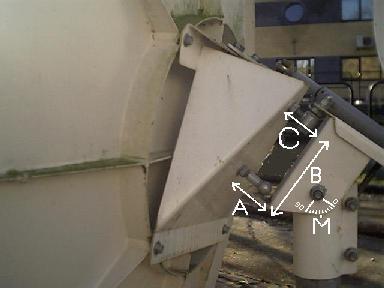|
home page |
Focal length of parabolic dish How to find offset angle of dish |
Correcting VSAT dish distortion. |
Setting up a polar mount satellite dish - offset feed dish (Example 3)
In this example, the reflector is an offset design with the feed on an arm at the bottom. It may be Echostar mount with a 1.2 Prodelin dish There is a triangular structure behind the dish..

Identify your latitude from a map or GPS receiver. North of the equator latitude is positive, the further away from the equator the greater the number. South latitudes are negative. Work it out as a decimal number. There are 60 minutes in a degree.
Examples:
51 deg 30 minutes north = 51.5 deg
50 deg 15 minutes north = 50.25 deg
45 deg 45 minutes north = 45.75 deg
20 deg 10 minutes south = - 20.166 deg
30 deg 20 minutes south = - 30.336 deg
Go to the satellite TV dish angle calculator and input your latitude. You can input zeros for the longitude of your site and the orbit longitude of the satellite, since longitude is irrelevant to the setting up of a polar mount. You are only interested in pre-calculating the polar mount main axis angle and the polar mount dish offset tilt angle.
Set the polar mount main axis angle using the scale shown at M or use a protractor or an inclinometer. The polar mount main axis angle is the angle between the line through the bearing and a horizontal line in a due north direction. If you are near the equator the polar mount main axis leans backwards a lot and the main axis angle is small and the dish aimed high up. If you are a long way away from the equator, the dish is aimed low down and the polar mount main axis angle is large and the bearing is only tilted backwards slightly.
In the above design of polar mount the polar mount dish offset tilt angle is achieved by setting length C greater than length A, so as to tilt the beam downwards a little.
Tighten up the hardware at A, using the fixed length spacer to define the gap. The nut shown above at the end of the spacer may or may not be required. The length A must be sufficient to allow the dish to swing freely to either side.
Write down the required polar mount dish offset tilt angle (it is a small angle less than 9 degrees) and calculate the tan of angle using a calculator. A suitable calculator is at start - programs - accessories - calculator - view - scientific. Check the result is consistent with the values in the table below.,
| tilt angle in degrees | 0 | 1 | 2 | 3 | 4 |
| tan(tilt angle) | 0 | .0174 | .035 | .052 | .07 |
| tilt angle in degrees | 5 | 6 | 7 | 8 | 9 |
| tan(tilt angle) | .087 | .105 | .123 | .14 | .158 |
Measure lengths A and B.
Note that tan (tilt angle) = opposite/adjacent = (C-A)/B
so B * tan(tilt angle) = C - A
so C = B* tan(tilt) + A
Work this out and find what C is supposed to be. Then set distance C.
Having set the two angles really carefully, centre the actuator and point the whole head assembly to due south by rotating the canister on the pipe at the bottom.
|
Amended 24 Feb 2014 |